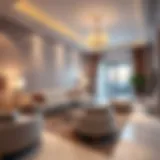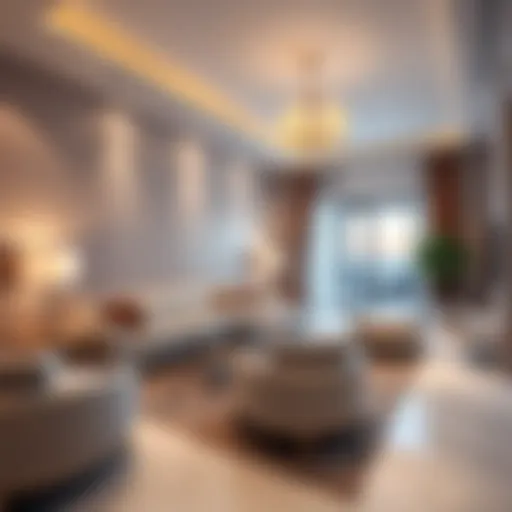Discovering Dubai's Walkable Pathways: A Detailed Guide
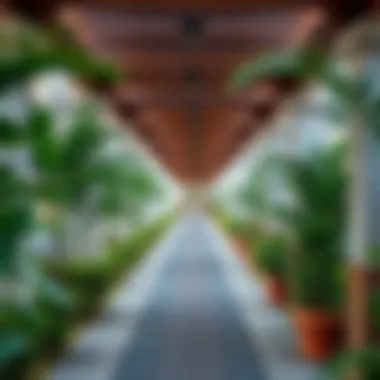

Intro
Dubai, a city synonymous with opulence and innovation, has been transforming not just its skyline but also its approach to urban living. Walking has become more than just a means of transportation; it’s a burgeoning trend in a rapidly growing metropolis. With its ambitious urban planning and initiative to promote sustainability, Dubai is designing spaces that cater to pedestrians while integrating nature and culture. This article dives into the walkable spaces that dot the city, highlighting how these pathways are significant both architecturally and culturally.
Pedestrian-friendly environments in Dubai encourage healthier lifestyles, bolster community interactions, and provide vital links between diverse districts. In a place noted for its towering skyscrapers and luxury shopping, the quiet, winding walkways offer an unexpected contrast. Knowing and understanding these areas enhances the experience of exploring the city, making it a noteworthy consideration for investors, homebuyers, and urban planners alike.
Through this guide, we will highlight the architectural ingenuity, cultural influences, and future prospects of these sidewalks and promenades. As these spaces develop, it’s essential to examine how they influence property markets and what this means for those looking to invest in Dubai’s real estate.
Market Insights
Current Trends in Dubai Real Estate
In the age of urbanization, Dubai remains at the forefront of real estate developments that lean towards more pedestrian-friendly designs. The City Walk project exemplifies this shift, merging lifestyle, leisure, and retail experiences. Developers increasingly focus on creating mixed-use spaces, offering residents varied amenities within walking distance. Furthermore, as more expats choose to settle in the emirate, the real estate market has seen a pivot towards properties that emphasize accessibility to these walkable zones.
Walking has been emphasized as a way to promote social engagement, with parks and project areas like Dubai Marina and Downtown Dubai often buzzing with activity. Developers are recognizing that to keep pace with a changing population, the need for inclusive and sustainable designs is paramount.
Market Forecast and Predictions
Looking forward, the growth trajectory in Dubai's real estate is poised to capitalize on the global trend towards healthier urban living. Analysts predict that as demand for walkable spaces continues to rise, property values in these areas will remain resilient. With the 2040 Urban Master Plan, the government aims to enhance pedestrian connectivity across existing and future districts, encouraging investment in areas that promote walkability.
Investors should note some key factors for the upcoming years:
- Increased government support for pedestrian initiatives
- Enhanced connectivity between various urban zones
- Development of green spaces alongside commercial and residential projects
As real estate professionals look to seize these opportunities, a clear understanding of how walkability impacts property demand will be crucial. Whether one is aiming to buy, sell, or invest, it will serve them best to keep an eye on these emerging trends.
"Walkable environments are no longer seen as just an amenity but as a critical component of urban development in Dubai."
In this rapidly evolving landscape, the forthcoming sections will delve deeper into the design considerations and future of walkable spaces, providing essential insights for anyone looking to navigate Dubai's urban pathways.
Preface to Walkable Spaces in Dubai
When it comes to urban environments, the notion of walkable spaces is often perceived as merely an amenity, yet in the context of Dubai, it carries a profound significance. Walkable spaces encompass more than just pathways; they represent the intertwining of daily life with the architectural and cultural tapestry of the city. As Dubai continues to evolve into a modern metropolis, understanding the dynamics of these pedestrian-friendly areas becomes essential not only for residents but for investors, homebuyers, agents, and developers alike.
By fostering a walkable environment, Dubai is positioning itself as a place where community interaction and healthier lifestyles flourish. A city with well-planned and accessible walkways enhances the quality of life for its inhabitants and visitors. Additionally, these spaces have a positive impact on local economies as they encourage foot traffic and promote engagement with businesses and services.
Defining Walkable Urban Environments
Walkable urban environments are characterized by their ability to support pedestrians safely and comfortably. In essence, they are areas designed to cater to foot traffic, allowing individuals to traverse without reliance on vehicles. A quintessential walkable space in Dubai integrates several key elements:
- Proximity: Destinations such as shops, parks, and recreational facilities should be within a reasonable walking distance from residential areas.
- Connectivity: Walkable pathways should be well-connected, allowing for direct routes that encourage exploration and ease of movement.
- Safety: Well-lit, maintained, and monitored paths enhance the feeling of security among walkers.
In the context of Dubai, where the urban landscape is marked by both innovation and tradition, the definition of walkable spaces also draws on cultural influences. Integration of local art, heritage sites, and green areas transforms ordinary pathways into engaging experiences.
Importance of Pedestrian Infrastructure
Developing robust pedestrian infrastructure holds immense value for Dubai as it transitions toward a more sustainable urban framework. There are several noteworthy advantages to investing in pedestrian-friendly zones:
- Health Benefits: Walkable areas encourage people to incorporate physical activity into their daily routines, combating sedentary lifestyles and promoting public health.
- Environmental Impact: Reducing reliance on vehicles contributes to lower carbon emissions and promotes cleaner air quality.
- Economic Growth: Well-designed pedestrian zones often stimulate local businesses, drawing shoppers and tourists into the area, thereby increasing profitability.
- Social Cohesion: Spaces where pedestrians share experiences foster community ties, enhancing social networks and civic engagement.
"In many ways, walkability is a reflection of a city's wider aspirations, capturing the essence of both connectivity and community."
As we peer into Dubai's vision for future developments, the focus on fostering walkable spaces stands out as a crucial element in shaping a truly modern—and livable—city.
Factors Influencing Walkability in Dubai
The concept of walkability has gained traction as urban centers evolve to embrace more pedestrian-friendly environments. In Dubai, the blend of tradition and modernity, along with rapid urban development, shapes the nuances of its walkable spaces. Understanding the factors that influence walkability in this metropolis can unveil not only the architectural elements but also the cultural, climatic, and social dimensions that define the pedestrian experience.
Urban Planning and Design Principles
Dubai's urban planning is a careful dance, balancing innovation with functionality. When architects and planners design pathways, they consider how these spaces accommodate flow, safety, and engagement.
- Connectivity: Walkable areas must seamlessly connect residential regions to commercial hubs, parks, and public transport. For example, the Dubai Marina Walk serves as a perfect case where living spaces are intertwined with leisure attractions.
- Aesthetic Considerations: Well-designed pathways enhance the visual appeal. Features like artistic installations and landscaping create an inviting atmosphere.
- Zoning: Mixed-use developments are crucial. They encourage walking by placing shops, restaurants, and parks within easy reach, making strolls more desirable.
By incorporating human-scale designs, the city encourages exploration and interaction among residents and visitors alike.
Climate Considerations in Pedestrian Pathways
The climate in Dubai presents unique challenges for walkability. With soaring temperatures, particularly in summer, the design and materials of pedestrian pathways must be attuned to the environment. Considerations include:
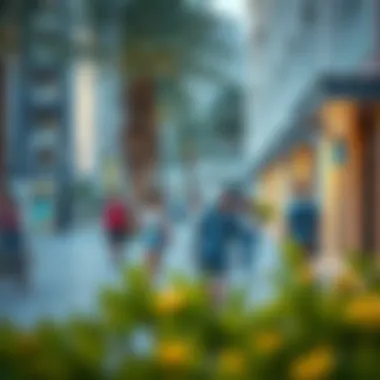

- Shade Structures: Installing awnings and strategically positioned trees can provide essential shade. This not only enhances comfort but also invites more foot traffic.
- Materials: Using lighter colored materials for walkways can reflect rather than absorb heat, creating a cooler surface to walk on.
- Cooling Features: Initiatives such as misting systems or water features can help mitigate the harshness of the climate, making walks more pleasant.
The success of walkable spaces in the city hinges on the ability to adapt to climate challenges while maintaining a commitment to pedestrian comfort.
Safety and Accessibility Features
A truly walkable environment is rooted in safety and accessibility. Ensuring that all residents can navigate these spaces freely not only promotes inclusivity but also fosters a sense of community.
- Lighting: Well-lit pathways deter crime and enhance user comfort. Nighttime strolls become less daunting when visibility is prioritized.
- Sidewalk Design: Wider sidewalks accommodate different pedestrian flows, including high foot traffic and those with mobility devices.
- Crosswalks and Signage: Clearly marked crosswalks and informative signage improve navigability and awareness.
Moreover, universal design principles advocate for spaces that accommodate all individuals, regardless of age or physical ability. A commitment to creating safe, accessible routes underpins the city's vision for a truly inclusive urban environment.
Investing in the factors that enhance walkability fosters economic activity, supports local businesses, and enriches community life.
By focusing on the essential aspects of urban planning, climate adaptation, and safety measures, Dubai stands poised to elevate its walkable spaces, making the city not just a place to live but a destination to explore.
Key Walkable Areas in Dubai
The walkable areas in Dubai are pivotal to understanding how the city has evolved into a pedestrian-friendly environment. These areas reflect the urban design that promotes accessibility and social interaction, essential for a thriving community. Walking spaces not only contribute to the city’s charm but also enhance the experience of both residents and visitors. They offer opportunities for leisure, socialization, and even health benefits, making walkability a cornerstone of Dubai's urban strategy.
Dubai Marina Walk
Dubai Marina Walk is an inviting, scenic promenade alongside the dazzling marina. Spanning approximately 7 kilometers, this lively stretch is lined with cafes, shops, and residences. It embodies the essence of leisure in Dubai. While walking here, one can see families enjoying time together, tourists snapping pictures against the backdrop of stunning yachts, and fitness enthusiasts jogging by.
Key features include:
- A mix of dining experiences, catering to diverse palates.
- Well-maintained pathways, which are broad enough for walking, cycling, or even rollerblading.
- Access to parks and green spaces, promoting relaxation amidst the urban bustle.
The Dubai Marina Walk exemplifies how walkable areas can enhance lifestyle choices, encouraging a sense of community and attracting both locals and tourists alike.
The Walk at JBR
The Walk at Jumeirah Beach Residence, or JBR, adds a uniquely vibrant flavor to Dubai's coastal landscape. It’s not just a promenade but a living space bustling with energy. Picture a stretch filled with art installations, street performances, and avenues adorned with palm trees swaying in sea breezes.
Here one can:
- Enjoy both upscale and casual dining with beachfront views.
- Engage in activities like shopping at boutique stores.
- Relish a beach day while still being part of a lively urban environment.
The synergy between the beach and the city is palpable; The Walk at JBR stands as a testament to how spaces can interweave leisure with everyday living.
Downtown Dubai Promenade
The Downtown Dubai Promenade is a striking example of architectural excellence meeting pedestrian-friendly design. This area offers stellar views of the Burj Khalifa, making it an ideal spot for sightseeing. The walk is adorned with fountains and artistic sculptures, enhancing its beauty.
Walking through this promenade offers:
- A chance to stop by various retail and dining venues, promoting local businesses.
- An atmosphere that encourages social interaction, with spaces conducive for gatherings and events.
- Sightlines that lead to some of the city’s most iconic landmarks, creating a memorable experience.
The Downtown Dubai Promenade illustrates how blending aesthetics with functionality can transform an area into a flourishing pedestrian hub.
Al Seef Waterfront
Al Seef embodies the charm of old Dubai while catering to modern needs. This waterfront merges the heritage of the city with contemporary architecture. It is not solely a place for walking; it's like stepping back in time while enjoying the waterfront views.
Visitors can:
- Explore traditional shops alongside modern retail experiences.
- Attend cultural events that celebrate Emirati heritage.
- Relax in parks adjacent to the water, fostering a serene atmosphere.
This blend of tradition and modernity makes Al Seef a vital focal point for both learning and leisure.
Bicycle and Walking Trails in Al Qudra
Al Qudra is an inspiring example of how Dubai promotes both walking and cycling as part of a healthy lifestyle. The trails here are well-maintained, winding through desert landscapes and making them ideal for those looking to escape the urban sprawl.
Important features include:
- Dedicated paths for cyclists and pedestrians, ensuring safety.
- Scenic views of the surrounding dunes, offering a breath of fresh air.
- Opportunities for wildlife spotting, which adds an extra layer of enjoyment to the journey.
Al Qudra's trails underline the city’s commitment to sustainability and well-being, encouraging residents to engage with the outdoors actively.
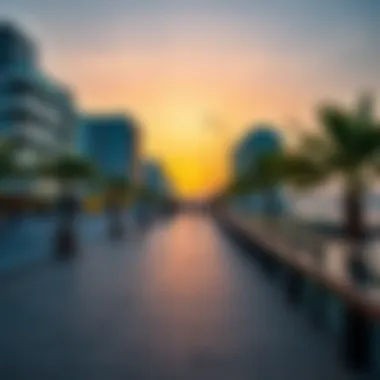

Sustainable Walkway Developments
Creating walkable areas that harmonize with the environment is becoming increasingly important in urban planning, especially in a rapidly growing metropolis like Dubai. Sustainable walkway developments contribute not just to the aesthetic appeal of a city but also to its functionality and ecological balance. The integration of sustainable practices in designing walkways leads to healthier communities and enhanced quality of life.
Green Spaces and Parks
Green spaces are often the heart of urban developments. In Dubai, parks and green pathways make strolls far more appealing. These areas do more than just provide a respite from the hustle and bustle. They offer a chance for residents and tourists to connect with nature, making spaces more inviting for all. Parks like the Al Barsha Pond Park or the Dubai Design District Park not only house greenery but also include walking and cycling trails that promote an active lifestyle.
Benefits of incorporating green spaces in urban walkways include:
- Improved Air Quality: Plants help filter pollutants, making the air cleaner for everyone.
- Biodiversity: Green spaces attract birds and insects, supporting local biodiversity.
- Mental Well-being: Access to nature has been shown to lower stress and improve general mood.
Integrating Nature with Infrastructure
The challenge and art of modern urban design lie in integrating nature with man-made structures. In Dubai, we see an increasing trend in developing walkways that are not only functional but also environmentally friendly. For example, the Dubai Water Canal has been developed to include walking paths bordered by trees and artwork, creating a visual feast that invites more foot traffic.
Key elements in this integration include:
- Sustainable Materials: Using recycled or locally sourced materials minimizes the environmental footprint of construction.
- Water Conservation: Implementing systems for water-efficient landscaping along walkways helps preserve one of the UAE's most precious resources.
- Wildlife Corridors: Designing pathways that allow for the safe passage of local wildlife can sustain the ecosystem amidst urban development.
"Sustainable designs are more than just a trend; they are a necessity for future urban planning."
This combination of nature and infrastructure is crucial, transforming Dubai's walkways from mere transit zones into vibrant communal places. In future developments, it's anticipated that projects will continue to prioritize these green integrations, further enhancing the city’s appeal as a walkable environment.
Cultural Significance of Walkways in Dubai
Walkways in Dubai serve more than just the function of enabling people to traverse between locations; they embody a deeper cultural narrative that intertwines urban life with social interaction, art, and the very lifestyle of the inhabitants. As we delve into the cultural significance of these pedestrian routes, it’s essential to grasp their role in shaping community identity and promoting vibrant social exchanges among diverse groups.
Community Interaction and Socialization
The design of walkways in Dubai fosters a sense of community. They act as meeting points, where individuals from various backgrounds gather and share experiences. For instance, the Dubai Marina Walk not only offers picturesque views but also hosts local markets and events that encourage community participation. Here, pedestrians can be seen engaging in spirited conversations, sharing meals, or simply enjoying the scenery together.
Moreover, these pathways promote inclusivity, allowing individuals of all ages and abilities to connect. By incorporating accessible features like ramps and interactive installations, they cater to everyone. This inclusive design encourages socialization and plays a pivotal role in weaving a tapestry of relationships within the community.
Local cafes and shops lining these walkways draw people in, facilitating spontaneous interactions. As one strolls through The Walk at JBR, it's common to observe families enjoying a meal, friends catching up over coffee, or tourists snapping photographs. Such dynamics transform simple pathways into lively social hubs.
"Walkways have a unique way of turning strangers into friends, bridging gaps between cultures and backgrounds."
Art and Installations Along Pathways
Art serves as a crucial element in enhancing the cultural fabric of Dubai’s walkable spaces. A prime example is the Al Seef Waterfront, where local artists have the opportunity to showcase their works. From murals that reflect the history of Dubai to sculptures that celebrate its future, these installations not only beautify the environment but also tell stories of the city’s evolution.
The integration of art along walkways is not merely for aesthetic purposes. It fosters dialogue, encourages creative expression, and heightens public awareness about various cultural themes. For example, visitors to Downtown Dubai Promenade are often captivated by the interactive art displays, which invite engagement beyond just observation. People stop to admire, reflect, and participate, making art a crucial part of their journey.
Additionally, cultural festivals or community events often feature installations that resonate with local customs. Such initiatives enhance the idea of place, making walkways memorable spaces where art and culture intersect.
Economic Impacts of Walkable Areas
Understanding the economic dynamics of walkable areas in Dubai provides important insights into how these pedestrian-friendly environments benefit the city's growth and development. Walkability has proven to be more than just an urban design principle; it can substantially affect property values, economic activity, and the overall attractiveness of a region. Residents and visitors alike tend to favor locations that prioritize accessibility and pleasant pedestrian experiences, which creates a ripple effect on the economy, both locally and regionally.
Enhanced Property Values
When it comes to real estate, location is paramount. Walkable neighborhoods often see higher demand, translating into increased property values. Homes situated near vibrant walkways or pedestrian pathways typically attract a premium. Factors contributing to this phenomenon include:
- Accessibility to Amenities: Properties that offer easy access to shops, parks, and public transit hubs generally command higher prices. Buyers recognize the convenience of being a short stroll away from essential services.
- Community Appeal: A walkable environment fosters a sense of community, drawing in potential homeowners who value local engagement over isolation. This social fabric often heightens the desirability of real estate in these areas.
- Reduced Transportation Costs: Walkable neighborhoods lower the reliance on vehicles, appealing to those looking to save on commuting. Potential buyers factor in these savings when assessing the overall value of property.
As a result, the presence of well-planned walkable spaces often leads to a steady appreciation in property values, making it a wise investment for both buyers and developers.
Attracting Tourism and Business
Walkability in urban settings acts as a magnet, drawing in both tourists and businesses. Key aspects include:
- Tourist Engagement: Visitors gravitate towards areas where they can explore comfortably on foot. Iconic locations like Dubai Marina and The Walk at JBR, with their pedestrian-friendly designs, showcase local culture, art, and cuisine, making them popular destinations. High foot traffic translates into increased sales for nearby businesses.
- Supporting Local Enterprises: Small businesses thrive in walkable spaces as they attract foot traffic. Cafés, boutiques, and galleries often benefit from being easily accessible. This vibrancy not only helps sustain local economies but can also foster unique entrepreneurial ecosystems.
- Business Attraction: Companies seek locations that enhance the quality of life for their employees. Walkable areas can promote a healthier workforce and improve productivity, thus becoming more attractive for businesses setting up shop.
In sum, the economic significance of walkable spaces in Dubai cannot be overstated. They add immense value to real estate, foster thriving local businesses, and enhance the city’s attractiveness to tourists. As urban designers and city planners look to the future, prioritizing walkability will undoubtedly pave the way for sustained economic growth.
"Walkable cities not only entice residents but draw in investments and tourism that bolster local economies."
For more information on the impact of walkability in urban areas, you can explore additional insights on Wikipedia and Britannica.
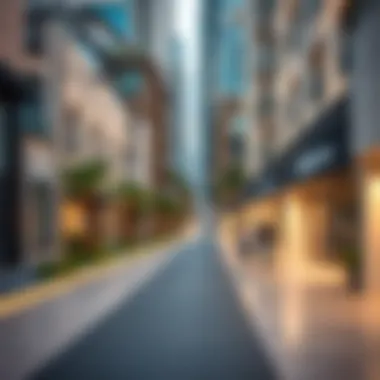

Challenges of Implementing Walkable Spaces
Creating a city where walking is not just possible, but enjoyable and safe involves overcoming several significant hurdles. In the context of Dubai, a place known for its towering skyscrapers and sprawling developments, challenges of implementing walkable spaces necessitate a thorough investigation. This topic is vital for urban planners, developers, and potential investors—a clearer understanding can lead to more effective strategies in creating pedestrian-friendly environments.
Navigating Urban Constraints
The urban layout of Dubai presents unique constraints that impact walkability. High-density areas often lead to congestion, making it difficult for pedestrians to navigate without feeling overwhelmed. Furthermore, considerable portions of the city are designed with vehicular transport as the primary focus. Wide roads and fast-moving traffic pose safety risks for pedestrians.
In addressing these constraints, some effective measures might include:
- Creating protected walkways that separate pedestrians from vehicles. This could involve building overpasses or underpasses.
- Implementing traffic-calming measures, like speed bumps and narrower streets.
- Rethinking transit stations to support seamless transitions between different modes of transport, allowing easy access for pedestrians.
As the population grows, the demand for accessibility increases tremendously. The community's desire for interconnected spaces must be reflected in urban development strategies.
Balancing Development and Heritage
Dubai is a city that thrives on innovation and development, yet it simultaneously possesses a rich cultural and historical tapestry. This juxtaposition raises concerns about ensuring that heritage sites are preserved while new developments aimed at enhancing walkability take place.
For instance, expanding walkable spaces around Al Fahidi Historical Neighborhood could create a vibrant atmosphere, yet planners must be cautious not to compromise the authenticity of this culturally significant area. Key factors to consider include:
- Incorporating local architecture within new projects to maintain the character of heritage sites.
- Cultural sensitivity when designing pathways and public spaces that respect traditional values.
- Collaborating with local historians and communities to ensure that the historical contexts are not lost to modernization.
As one expert puts it,
"The challenge lies not only in creating space for pedestrians but in doing so while keeping the cultural essence of the city intact."
By striking a balance between development needs and heritage preservation, Dubai can lead the way in showing that modern urbanization does not have to come at the expense of its historical identity.
As the city evolves, the dialogue surrounding these challenges becomes increasingly critical. Investors, developers, and urban planners must collaborate, developing a strategic blueprint that respects the past while embracing the future in their quest for walkable urban spaces.
Future Directions for Walkability in Dubai
As Dubai continues to grow, the focus on walkability takes on added importance. A well-designed pedestrian environment not only enhances the livability of urban spaces but also reflects a commitment to sustainability, increased public health, and community cohesion. With more individuals seeking connected, pedestrian-friendly environments, attention to the future of these walkable spaces in the emirate can lead to smarter investments and significant community benefits.
Innovative Urban Solutions
Urban planners in Dubai are looking at innovative concepts that address the current needs while anticipating future demands. One of the critical solutions revolves around creating mixed-use developments that combine residential, commercial, and leisure spaces within well-defined walking districts. This compacts urban life and minimizes the dependency on residential or personal vehicles. Promoting walking paths that link various neighborhoods will cultivate a sense of connectivity, reducing commuting times and fostering community interactions.
Implementing pedestrian-friendly infrastructure can take many forms, such as:
- Green corridors: These pathways not only enhance aesthetics but serve ecological functions, providing habitats for birds and insects while creating refreshing shaded spaces.
- Pop-up parks and community spaces: Strategically placing temporary parks or gathering spots can engage residents while offering meaningful community interactions.
- Enhanced public transport connections: Integrated transit systems that complement walking pathways enhance accessibility and bridge gaps in the urban fabric.
By incorporating these innovations into the architectural and urban planning lexicon, Dubai can create environments where walking is more than a mode of transport—it becomes an experience of exploration.
The Role of Technology in Enhancing Walkways
Technology is poised to change the face of walkability in Dubai. The implementation of smart city solutions can greatly enhance the pedestrian experience. Think of it this way: sidewalks could become interactive information hubs. Users could access everything from transit schedules to upcoming events or even local history just by walking past them. Imagine sensors alerting pedestrians and cyclists of approaching vehicles, enhancing safety and awareness.
Some examples of technology applications are:
- Mobile applications and platforms: Users can find routes, estimated travel times, and even recommendations for green spaces along their path, thus encouraging use and enjoyment of walkable areas.
- Smart street lights: Equipped with sensing technology, these can adjust their brightness based on foot traffic, ensuring safety while conserving energy.
- Data analytics: Collecting foot traffic and behavior data via technology can inform future planning decisions, identifying potential improvements for path accessibility and comfort.
Technological advancements are crucial in keeping pace with Dubai's evolving urban landscape. By embracing these innovations, the city can enhance pathways, making them attractive, safe, and informed environments for walking, thereby promoting a healthier, more vibrant community.
Ending on the Potential of Walkable Dubai
As we reach the end of our comprehensive exploration of Dubai’s walkable spaces, it becomes ever more apparent that these pedestrian pathways are not merely routes for strolling. They are central veins in the city's urban framework, fostering community interaction, enhancing property values, and inviting tourism. The rise of interest in walkable environments presents a unique opportunity for both investors and urban planners to contribute to the city’s ever-evolving landscape.
In Dubai, walkability isn't just a trend; it's a necessity. With the ongoing push towards sustainability and reducing carbon footprints, the development of more pedestrian-friendly spaces will play a key role in reshaping the city's identity. Embracing walkable designs can significantly improve quality of life, facilitating healthier lifestyles by encouraging walking and active transportation forms.
Moreover, by integrating art, greenery, and community spaces into these walkways, the city can provide its residents and tourists with a richer, more engaging experience. Enhancing these aspects will lead to an increased sense of belonging and pride among residents, which is often a crucial factor in urban development.
Summarizing Key Insights
To summarize, walkable Dubai is more than just an urban ideal; it's a multifaceted approach to living within a bustling metropolis. Key insights to take away include:
- Health Advantages: Walkable spaces promote physical activities, contributing to overall community wellness.
- Economic Benefits: Well-designed pedestrian infrastructures elevate local business and tourism opportunities.
- Social Connectivity: These pathways also serve as gathering spots, fostering connections among diverse populations.
- Enhanced Urban Aesthetics: Integrating cultural and artistic elements into walkable spaces creates a visually appealing capital.
The movement towards walkable urban areas represents not only a shift in how we think about city thriving environments but also in what constitutes a vibrant city life. Each new project or development stands as a testament to headline plans aimed at enhancing the pedestrian experience.
Final Thoughts on Walkable City Planning
As urban landscapes continue to reshape, the need for emphasis on walkability remains critical. Future city planning must prioritize accessibility and sustainability alongside economic growth. To build these walkable areas effectively, it's vital to engage various stakeholders, including residents, urban planners, and businesses, ensuring that community voices are not just heard but are instrumental in setting direction.
Incorporating innovative technologies, such as smart lighting and interactive signage, can further enhance the pedestrian experience. Moreover, social campaigning focused on sustainable transportation options can raise awareness and shape behaviors around embracing walking as the preferred mode of transport in urban settings.








